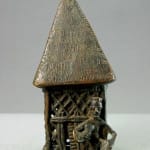Kulango Bronze Sculpture of a Hut, 20th Century CE
Bronze
3 x 7
PF.5919
Further images
Gazing upon this bronze sculpture, we can almost feel the heat emanating from the Sub-Saharan sun. As perspiration begins to drip down our foreheads, we too search to seek relief...
Gazing upon this bronze sculpture, we can almost feel the heat emanating from the Sub-Saharan sun. As perspiration begins to drip down our foreheads, we too search to seek relief from the sun under the shady cover of a thatched roof. Perhaps we’d take a seat next to this man and pass the time exchanging tales and discussing the events of our lives. Surely this stunning sculpture displays such a simple scene of our daily lives immortalized through the durable medium of bronze. The Kulango tribe is closely related to the neighboring Akan peoples. It is perhaps through the Akan, who are noted for their metalwork, that the Kulango learned the technical prerequisites of this art form. Such scenes of daily life are typical of Akan art. Akan gold weights are famous for their depictions of chores and daily duties as well as depictions of popular folktales. It is possible that this sculpture might detail such a proverb. Perhaps it might have served as a protective cover for a sacred object. Thus the man would become a guardian who would protect the contents from any evildoers. Overall, the detail on this sculpture is indicative of the finest African metalwork. The latticework of the walls recalls the Ancient art of the Benin kingdom, the unrivalled masters of African metalwork. The pyramidal roof has been carefully incised with curved lines representing the texture of the thatching. Overall, the beauty of this work is astounding, both in regards to the technical craftsmanship as well as the theme.









